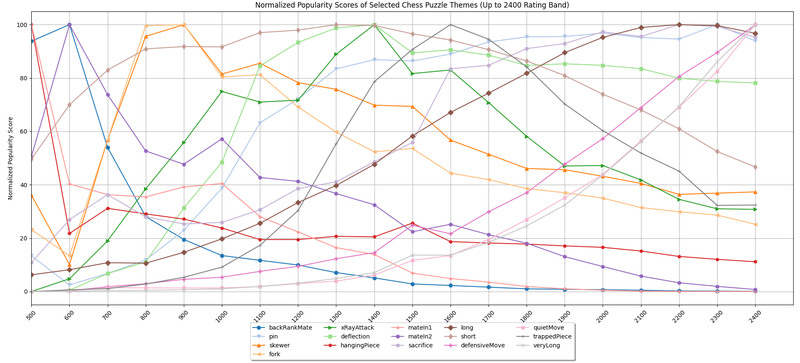
Normalized Popularity Scores of Selected Chess Puzzle Themes on Lichess
The other day I entered into a debate with GM Jacob Aagaard and IM Andras Toth on X about whether tactics trainers are worse compared to author-selected puzzle books.
See the diagram in large here
I see benefits for both the curated selection of puzzles, but also for the algorithmically selected puzzle you are served online. One downside of the human-curated selection is that you sometimes can guess the solution because the material is very thematic.
This made me think about how the Lichess puzzle themes are “curated” and at what rating bands you see the most of a specific theme. The above plot is a try to dive into the Lichess puzzle database. I have divided the puzzles into 100-point rating bands. Then a percentage representation for each theme is calculated within the rating band. The specific theme percentages across the rating bands are then compared and transformed into a 0-100 score. 100 represents the band where the specific theme is shown the most often.
If we look at the fork theme it peaks at the 800-900 rating range and then slowly drops. Skewers also peak at around 900. Deflections and X-ray attacks peak around 1400, and a trapped piece at 1600.
We also see that the long solution puzzles (brown) slowly rise as we progress in difficulty only to go down when the very long solutions begin to take over.
The Lichess rating system in a way curates the themes for the users for when they are ready to work on this specific area. That is also something The Tactics Ladder books, that I have made with Lichess puzzles, will show you. In the first book, there will be a good share of back-rank tactics. When you have learned this pattern you advance to learn new themes not decided by me, but by the rating system created by people solving and failing to solve the puzzles.
I’m not saying puzzle trainers are better than curated puzzle books, but they do offer something else and I hope the plot helps show this a little better and maybe can give future debates about what is the best resource a little more nuance.
The above newsletter was sent out to the readers of Say Chess. If you have not yet subscribed consider doing it if you like subjects like chess improvement, chess book publishing, and articles about the chess world.
/Martin
You may also like
 FM CheckRaiseMate
FM CheckRaiseMatePriyomes
The most important chess concept you've never heard of SayChessClassical
SayChessClassicalThe Great Eval Bar Debate: Chess.com's Broadcasting Style
Should chess tournament broadcast feature an eval bar or not? SayChessClassical
SayChessClassicalAre Online Chess Players Trapped Pigeons?
The Increasing Gamification of Online Chess Lichess
LichessFIDE adjusts its ratings to be more in line with Lichess (not really)
When Elo meet Glicko! NDpatzer
NDpatzerScience of Chess - Problem Solving or Pattern Recognition?
We often say chess is a game of patterns, but here I look at a study that suggests it is also a game… SayChessClassical
SayChessClassical